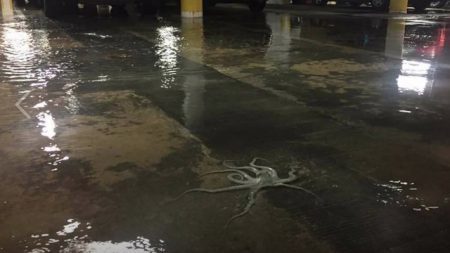December 15, 2016 – “We’re looking to a future where we’re going to be underwater,” states Coral Gables, Florida, Mayor Jim Cason. He and Dawn Zimmer, Mayor of Hoboken, New Jersey, are among a group of mayors who have produced a report entitled, Roadmap to Support Local Climate Resilience: Lessons from the Rising Tides Summit. A working paper being released today, the report calls on the incoming U.S. President, Donald Trump, and the Republican-dominated Congress to support local action on climate change adaptation. The mayors hope to see a good chunk of the infrastructure project money President-elect Trump talks about devoted to addressing climate change impacts on their cities.
Why?
Because to-date only 14 U.S. states have comprehensive plans in place for mitigation and adaptation to deal with changing climate and there are 23 coastal U.S. states which will be impacted. That is an underwhelming response to a visible challenge these mayors see with increasing frequency.
In October 2015, the Rising Tides Summit attended by officials from 18 of the 23 coastal U.S. states met to discuss the climate change role the federal government could play. Now with a President-elect who is known more for his endless climate-change denying tweets, it is apparent that the officials from the federal government who attended the Summit, NOAA, FEMA and the U.S. Army Corps of Engineers, not be dissuaded from assisting with climate resilience projects.
Why describe climate change as an octopus?
It goes back to an event that occurred during Florida coast seasonal high tides in November of this year with an octopus washed up into a Miami Beach parking garage. The symbol and evidence of that octopus represents a call to action. States Mayor Zimmer, “the seas are rising, and stronger storms really don’t care whether you’re a liberal or a conservative….It’s going to keep getting more and more frequent and more and more severe.”

What the mayors are asking for is summed up in eight policies:
- Increased pre-disaster assistance including “disaster deductible” policies requiring states to pay a deductible before receiving federal disaster assistance with that deductible lowered if the state creates its own pre-disaster resilience initiatives.
- Commitment by states and local governments of taxpayer dollars to long-term infrastructure projects with multiple decade lifetimes to account for future climate change impacts and tie federal disaster assistance to long-term future risk.
- Coordination of federal, state and local governments on implementing resilience strategies through creation of a permanent National Center for Resilience within the National Security Council.
- Prioritize pre-disaster support for those communities most at-risk looking at low-income, vulnerable populations, historic inequities, and relocation investment and guidance.
- Use public-private partnerships to supplement government efforts through instituting resilience competitions as a recurring federal program, and developing finance mechanisms such as tax credits to provide private partnership incentives on retrofits and new builds that address climate impacts.
- Reduce carbon pollution and implement green infrastructure and natural environment solutions with federal government cost-sharing in place for mass transportation systems, reduced energy consumption, and renewable energy projects.
- Accurately measure impacts of climate change that go beyond current vulnerability assessments and develop metrics to measure resilience improvements.
- Inform the general public and policy makers about climate-related risks and resilience producing location-specific data and toolkits that address local vulnerabilities, and mitigation and adaptation costs.
States Mayor Zimmer about past practices, “Very much the policies are set up in a way where we’re reactive instead of proactive.” But if the recommendations described in the Summit report get appropriate attention and funding then it forecasts that “every $1 invested in pre-disaster resilience,” will end up saving “an average of $4 in future damages.”
Those who wrote the Summit report state in their conclusion that the President-elect can use the recommendations as a roadmap for addressing national infrastructure needs. They state, “this paper can provide guidance to the new administration for ensuring that its investments help communities and local governments enhance their resilience to threats like sea level rise and increasingly extreme weather.” It is no more than what Trump himself asked of the Irish government in helping him to address rising sea levels and coastal erosion threatening one of his golf courses.









